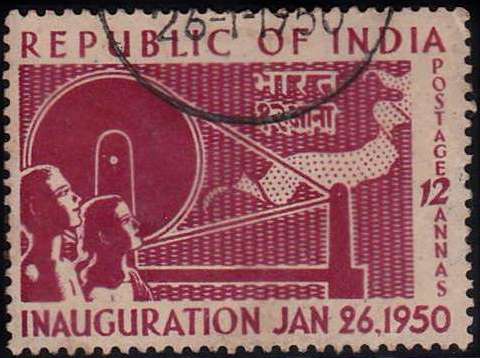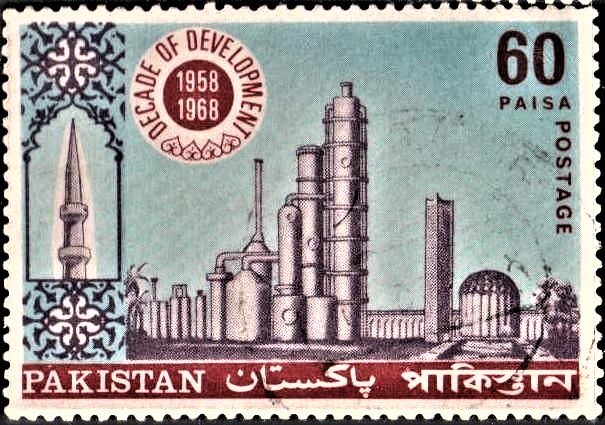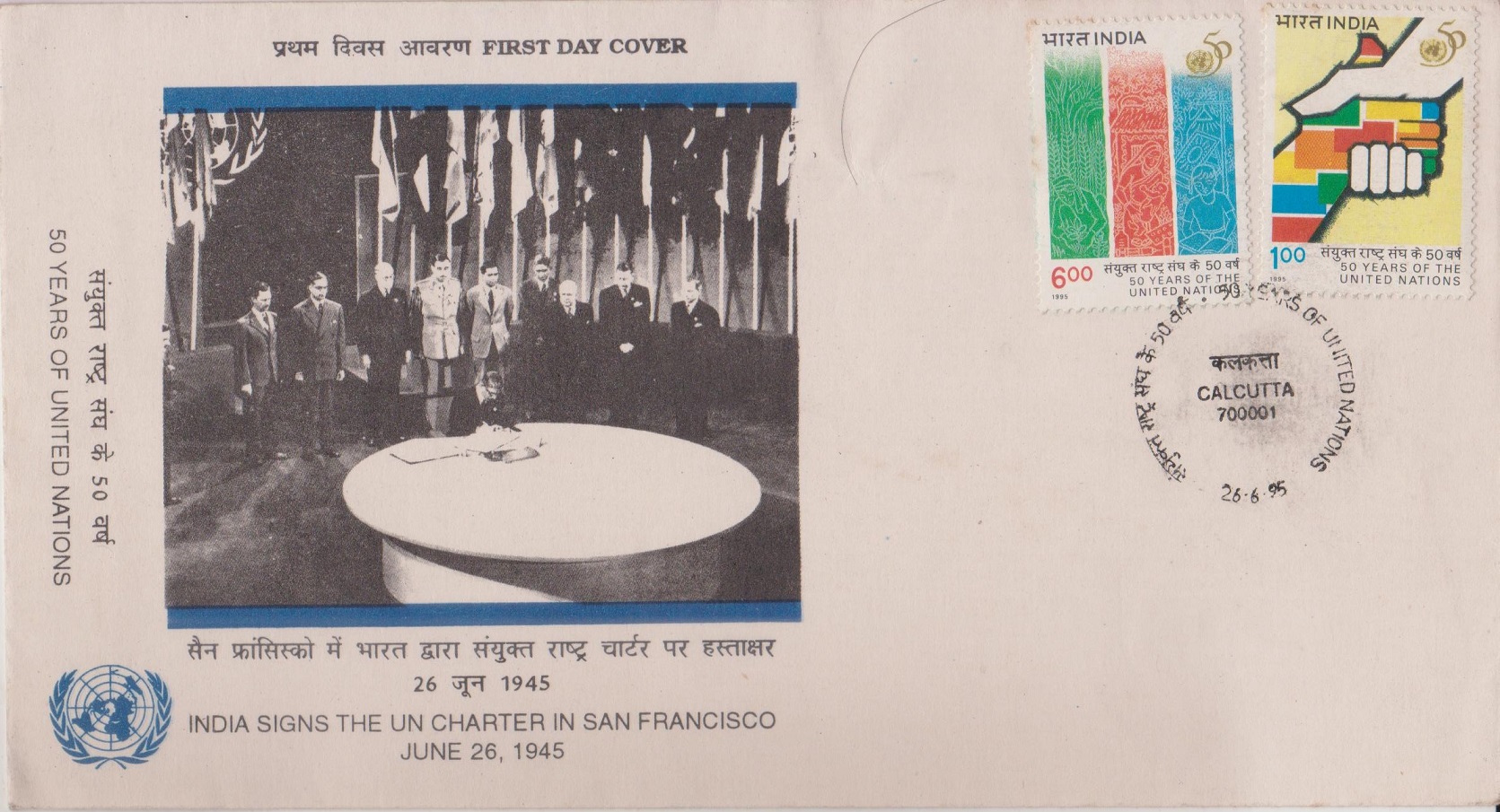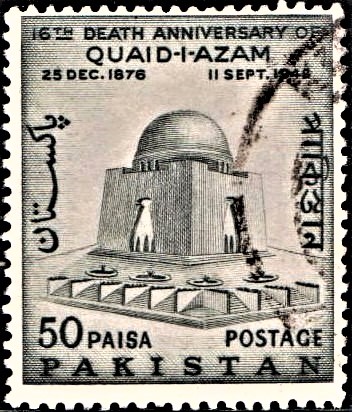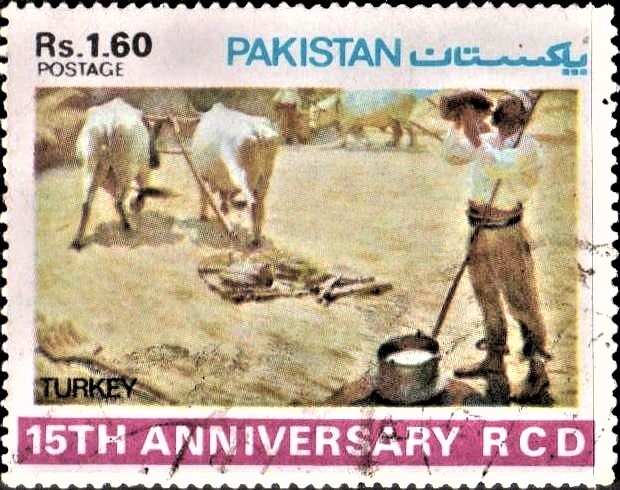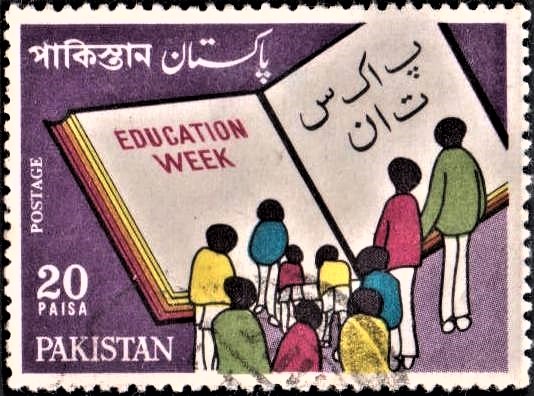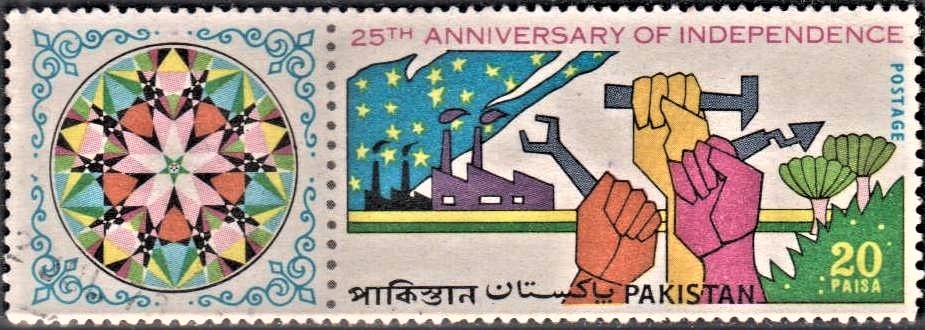
Twenty Five Years of Pakistan
Complete set of 6 nos. of commemorative postage stamp on the 25th Anniversary of the Independence :
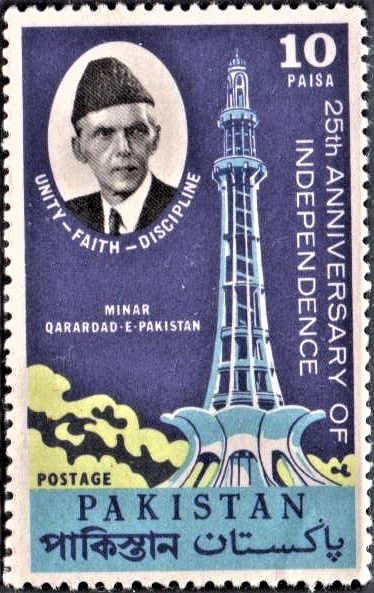
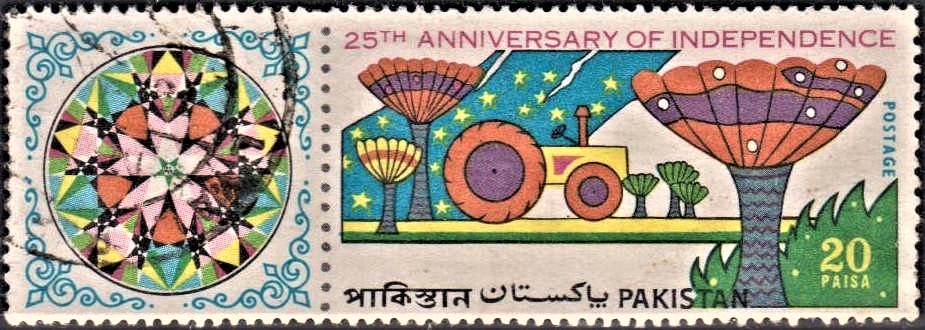

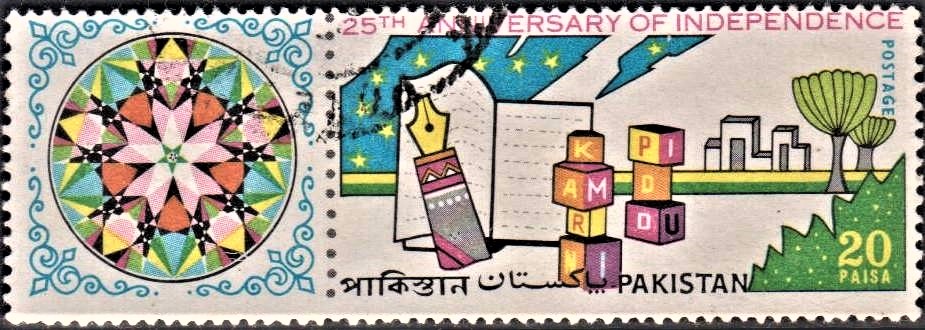

 Issued by Pakistan
Issued by Pakistan
Issued on Aug 14, 1972
Issued for : To commemorate the 25th Anniversary of Independence, the Pakistan Post Office is issuing a set of six stamps (one of 10 Paisa, four stamps of 20 Paisa each and one of 60 Paisa denominations) on 14th August, 1972.
Design :
10-Paisa : The format of the Stamp is vertical. The portrait of the Quaid-i-Azam appears in black and white on the top left side in an oval inset against an ultramarine background. The words “Unity–Faith–Discipline” in reverse appear underneath the portrait. The Minar–e–Qarardad–e–Pakistan is placed on the right side, against an ultra-marine background and the words ‘Minar Qarardad-e-Pakistan’ lie on the left of the Minar, in reverse. The value ’10 Paisa’ is placed on the top right corner of the Stamp in reverse and the words “25th Anniversary of Independence” lie on the right side of the Stamp in reverse. The tree and foliage behind the base of the Minar are in light and dark green. The word ‘Postage’ on the bottom left corner is in dark green. A strip at the bottom of the Stamp is turquoise colour, bears the word, ‘Pakistan‘ in English, Bengali and urdu in ultramarine.
60-Paisa : The format of the Stamp is horizontal. The caption “Inauguration of First National Assembly Elected on Adult Franchise” is in reverse and is placed on the top against a pink background, the value ’60 Paisa’ lies on the top left side of the stamp in reverse. The State Bank Building at Islamabad where the National Assembly is meeting, forms the subject of the design. The words “25th Anniversary of Independence” on the right side of stamp, the word ‘Postage’ on the left side, and the word ‘Pakistan‘ in Bengali, English and Urdu placed at the bottom of the stamp are all in red colour.
20-Paisa : The format of the stamps is horizontal. The set of four stamps depicts four principle reforms. The layout is the same for all the stamps. On the left side is a decorative pattern and on the right, separated by perforation like dots the design executed symbolically which varies according to the subject. The caption “25th Anniversary of Independence” is placed on the top in red. The word ‘Postage’ lies on the right side of the stamp in blue colour. The words ‘Pakistan‘ in Bengali, Urdu and English are in black, at the bottom of the stamp. The value ’20 Paisa’ is in yellow, and is placed on the foliage, on the right bottom side of the stamp. A sky covered with stars, common to all the designs, stands for the new avenues discovered in all fields and the progress made in agriculture, industry, education and health.
One of the designs symbolises the land reforms. A tractor and fields are shown in the background and trees in abstract form in the background on either side of the tractor and in the foreground on the right side of the stamp.
The second stamp stands for the labour reform in Pakistan. In the background are factories and in the foreground are hands of labourers holding tools, on the right side of the stamp. Trees in abstract form are shown on the right side behind the foliage.
The third design symbolises the education policy showing a pen, a book and cubes with alphabet on the left side of the stamp and a school building in the background on the right, as well as trees, in abstract form.
The fourth design shows a hospital building in the background with a red cross, a syringe, bottles of medicine and a pair of surgical scissors, signifying the new health policy.
Type : Stamps, Postal Used
Denomination : 10, 20 (4 nos.) & 60 Paisa
Colour :
10 Paisa :Green, turquoise blue, ultramarine and black
60 Paisa : Pink and red
Four 20 Paisa Stamps : Yellow, peacock blue, magenta and black
Size of Stamps :
10 Paisa & 60 Paisa : 49.2 x 30.7 mm
4 Stamps of 20 Paisa each : 78 x 26.7 mm
Size of prints :
10 Paisa & 60 Paisa : 46.2 x 27.7 mm
4 Stamps of 20 Paisa each : 75 x 23.7 mm
Perforation :
10 Paisa & 60 Paisa : 13 x 13 (c)
4 Stamps of 20 Paisa each : 12½ x 14 (c)
Quantity printed : 10,00,000 each
Number of Stamps in each sheet :
10 Paisa & 60 Paisa : 50
4 Stamps of 20 Paisa each : 48
Process of printing : Litho offset
Printers : The Pakistan Security Printing Corporation Ltd., Karachi
About :
- Pakistan, it has been observed, is the first attempt in modern times to build a political community on the basis of common religious beliefs. The decline of Muslim community in India started in the beginning of the eighteenth century during which period suppressed hostility of the subject peoples such as the Marhatas in the West, Jats, Sikhs and Rajputs in Northern India and other religious groups organized resistance against the authority of the Mughals. This resistance was facilitated by the appearance of the Europeans on the scene in the Deccan and in Bengal, and the increasing pressure on the North Western Frontiers from the Persians and Afghans. By 1803 Delhi had been occupied by the British and within another fifty years, the British had secured complete control over nearly the whole of India. The events of 1857-58 put the final seal on the fate of the Muslims.
- As a result of the loss of power and the challenge posed by the rising Hindu militant movements and the application of Western Political ideas in administrative educational and economic fields the consciousness slowly grew amongst the Muslims that their very survival was in danger as they had been left behind in the field of education industry and administration. The new democratic principles of representative government implied the supremacy of the numerical majority i.e. the Hindus. This majority was defined permanently in religion in the tradition-bound caste-ridden Hindu society. It was feared that however broad the franchise and the promises of free and fair elections, Hindu and Muslim voters would support the candidates of their own community, thus giving a constitutional basis to Hindu majority over the Muslims. The natural result was that the Muslims came to the conclusion after considerable mental conflict that they must establish a state of their own in order to preserve and perpetuate their identity as a distinct nation. Sir Syed Ahmad Khan was the first to openly proclaim the existence of two different and distinct nations in India.
- Doubts were expressed, both in India and abroad as to the Muslim claim to separate nationhood. Even Mahatama Gandhi expressed his doubts about it but he was adequately replied by Quaid-i-Azam in the following words –“We maintain that Muslims and Hindus are two major nations by any definition or test as a nation. We are a nation of a hundred million, and what is more, we are a nation with our own distinctive culture and civilization, language and literature, art and architecture, names and nomenclature, sense of values and proportion, legal laws and moral codes, customs and calendar, history and traditions, eptitude and ambitions; in short, we have our own distinctive outlook on life and of life. By all the canons of International Law, we are a nation.”
- Syed Ahmd had succeeded in keeping the Muslims away from joining the Congress and becoming its camp followers. After his death the political, social and economic situation had changed and it was not possible to keep the Muslims away from politics for all times to come. The Muslim leaders came to the conclusion that separate electorate would serve their purpose for the present. In 1906 Muslim League was founded and Bengal had the distinction of having given birth to the new political organization. The Partition of Bengal was hailed by the Muslims but was bitterly opposed by the Hindus with the result that within seven years the partition was annulled which not only affected Hindu-Muslim relations but created distrust in the intention of the Government. As a result of the changing internal situation there emerged the League-Congress understanding which resulted in the Lucknow pact. In 1916 the Congress accepted the Muslims claim to separate electorate for the first time, and also for the last time.
- The agreement was short lived and Muslims now began to think of alternative solutions to their problems. Constitutional safeguards in a United India appeared to be unsatisfactory and undependable. There were many suggestions, though not seriously taken of dividing the country between Muslim and Hindus. The first Muslim thinker to give expression to this idea, though in a vague and rudimentary form, was the late Allama Mohammad Iqbal. In his address to the All India Muslim League Session of 1930 at Allahabad, he advocated the creation of a consolidated Muslim State which he believed would be “in the best interest of India and Islam”.
- Mr. Jinnah, who was in self imposed exile in London, at first did not accept Iqbal‘s arguments but within 10 years he had finally been led to Iqbal‘s conclusion as a result of careful examination and study of the constitutional problems facing India. The culmination of this contagious idea of Muslims being a separate nation found expression in the famous Lahore Resolution of March 3, 1940 adopted at the Lahore Session of the Muslim League. In main the Resolution demanded :“That it is the considered view of this session of the All India Muslim League that no constitutional plan would be workable in this country or acceptable to Muslims unless it is designed on the following basic principles, namely, that geographically contiguous units are demarcated into regions which should be so constituted, with such territorial readjustments as may be necessary, (and) that the areas in which the Muslims are numerically in a majority, as in the North Western and Eastern Zones of India, should be grouped to constitute ‘Independent States’ in which the Constituent units shall be autonomous and sovereign.”
- The Indian Newspapers coined the phrase “Pakistan Resolution” which Mr. Jinnah adopted and later on asserted that no power could now prevent Pakistan. From that time onward Pakistan became not only a slogan but a creed with the majority of Muslims of all classes in all parts of the country. In the park where the resolution was passed, the ‘PAKISTAN MINAR‘ has been built and has become a place of pilgrimage for Pakistanis. Mr. Jinnah had by then become the ideal of Muslim masses and came to be affectionately called the Quaid-i-Azam.
- From 1940 to 1947 every effort was made at many levels to keep the country united, but all these attempts failed to make the Quaid give up the idea of partition, mostly because of the intransigence of the Congress and other Hindu communal parties to realize the justness of Muslim demands. The election of 1946, gave the League a resounding electoral victory which silenced or swept away those Muslim groups which still hoped to reach a compromise with the Hindus and made the Congress and the British to concede partition and independence. Failing to bring about a consensus of opinion between the League and the Congress, Mr. Attlee, the British Prime Minister declared in Feb. 1947 that His Majesty’s Government intended to take necessary steps to effect the transference of power to responsible Indian hands not later than June 1948. Lord Mountbatten who had been appointed the Viceroy and Governor General, however, declared in his plan of June 3, 1947 that independence would be granted on 14th August, 1947 that is within 75 days. This haste to grant independence did not affect India much but Pakistan had to start from scratch in order to establish a new Capital, a new Government and a new Secretariat at Karachi without proper housing accommodation for the new Government, without equipment and without adequate financial resources. Besides this on account of the communal riots, Pakistan was confronted with the problem of accommodating huge number of refugees which constituted nearly 1/10th of the total population. It may be added that nearly 65 lakh Muslims fled from India and 55 lakh Hindus and Sikhs left Pakistan.
- On the establishment of Pakistan on the 14th August, 1947 the Quaid-i-Azam while addressing the people declared in his presidential Address to the Constituent Assembly of Pakistan as follows :–“You are free; You are free to go to your temples, you are free to go to your mosques or to any other places of worship in this State of Pakistan. You may belong to any religion or caste or creed; that has nothing to do with the fundamental principle that we are all citizens and equal citizens of one State”.
- On August 14, the Quaid-i-Azam became the first Governor General of Pakistan.
- A Boundary Commission had began appointed under Lord Radeliffe to determine the boundaries of the two newly created states. When the Award was announced, the Quaid-i-Azam and the Muslims were shocked and Mr. Jinnah described it as “a grave injustice to Pakistan”, but accepted it as the party had agreed to arbitration.
- Pakistan came into being under adverse circumstances and as a European writer remarked the new born baby was thrown with its swaddlings into a raging river. That it survived the initial shock and disorder was entirely due to the innate good sense of the people, and their dedication to the difficult task of making Pakistan a viable state under the fostering care of one of the greatest leaders among the Muslims of the 20th Century. His dedicated lieutenants, the civil services, the army and the new industrialists deserve all praise for this. But as time passed on, particularly after the death of Quaid-i-Azam and the assassination of Nawabzada Liaqat Ali Khan, cracks began to appear in the national edifice. Dedication and patriotism gave place to pursuit of power, prestige and wealth. Corruption and nepotism ate into the very vitals of the society, and slowed down the process of reconstruction and nation building. Lacking proper leadership, deriving its authority from the will of the people as their elected representatives, politics became a profession for a few leaders and families. Economic and social growth began to deviate drastically from the goals which the Father of the Nation had set before us.
- The erosion of democracy in Pakistan and the disgraceful exploitation of the poor by the rich and of the weak by the strong led to the imposition of Martial Law in 1958. President Iskandar Mirza appointed General Ayub as the Chief Martial Law Administrator. This imposition of Martial Law was only a variant of Fascism through the agency of the army. It was natural that with the passage of time such military administration would degenerate into rule by a governing clique uninspired by any loftier ideology than clinging to its privileged position.
- Considerable advance was made in industrial development which however was lop-sided. Instead of sound planning for the good of the country as a whole and the common man at large a system of patronage in licence giving became the order of the day. In the absence of a constitution made by a National Assembly elected by the representatives of the people in a fair and free election, various subterfuges were resorted to in order to delay elections and have a constitution on the basis of adult franchise reflecting the wishes of all section of the people. The 1962 Constitution which had some good points was suspected from the very beginning as it was opined that it was a means of perpetuating the concentration of power in the hands of one person.
- The war with India in 1965 acted as a cement in bringing together all sections of the people in a concerted determined effort to meet the challenge of Indian Aggression. After the Tashkent Declaration which has for long been the subject of acrimonious discussions because of the mystery in which it is shrouded, a development of far reaching implication was that Mr. Zulfikar Ali Bhutto resigned as Foreign Minister in 1967 and addressed himself, with his ability and experience, to the creation of a new Political Party. This was the beginning of the end of the Ayubian era. The accumulated grievances of the people of East Pakistan, real and imaginary were expressed in the famous six points of Mujibur Rahman. The Pakistan Peoples Party was founded in Lahore in 1967 and it soon won considerable strength to lead a revolt against the dictatorship of Field Marshal Ayub Khan. Ayub Khan had to quit by handing over power to the then Commander-in-Chief, Agha Mohammad Yahya Khan on 25th March 1969. The story of Pakistan from this date to 20th December 1971 is too tragic and painful and too well known to be repeated. General Yahya Khan was finally compelled on 20th December, 1971 to transfer power to the leader of the majority, the Pakistan Peoples Party, President Zulfiqar Ali Bhutto. The President with his characteristic energy, grasp of the international situation, knowledge of the potentiality of his own people and his country’s resources set about to salvage what was left of Pakistan which had been the dream and the hope of millions of people.
- He has initiated many reforms of far reaching implications. Chief among them are the following :–
- Labour Reforms: On February 10, the Government announced its New Labour Policy, which is designed to “guarantee to workers their fundamental rights consistent with the requirements of industrial development of the State.” For the first time in the history of the country workers were allowed to participate in the management to the extent of 20 per cent at factory level which was to be increased progressively.
- Land Reforms: The land reforms introduced by the President Mr. Zulfiqar Ali Bhutto on March 1, 1972 were intended to bring dignity and salvation to our rural masses. The ceiling on individual land holding was drastically reduced and some 3.5 million acres of land was resumed by the Government without compensation and distributed amongst the landless peasants free of cost. This would benefit some 2.5 million poor farmers and landless tenants.
- Education Reforms: The new Educational Policy, announced by the Government on March 15, is a bold measure to eradicate illiteracy and to make education a means to achieve the national goal. It aims at providing uniform educational facilities to all children and to democratise education. Among the measures taken in this respect are free education up-to class VIII from October 1, 1972 and upto class X from October 1, 1974, a massive programme of adult literacy; establishment of a People’s University and of literacy centres and peoples libraries throughout the country.
- Health Scheme: On March 26, President Bhutto made public his seven year Rs. 3,800 million “People’s Health Scheme” for providing health facilities to each and every citizen of Pakistan. The Scheme envisages the establishment of a net-work of health centres throughout the country which will cater to the medical needs of the people.
- Besides the above reforms initiated within six months of assuming office, Mr. Zulfiqar Ali Bhutto must be credited with the foresight of losing no time in getting a Constitution passed by the First National Assembly elected on the basis of adult franchise and lifting the Martial Law and restoring fundamental rights to the people. The most outstanding contribution of Mr. Zulfiqar Ali Bhutto has been the Simla Accord which, except by a negligible minority, has been hailed as the harbinger of a new era of peace, amity and friendship with India.
- Issued by The Director-General Pakistan Post Office, Karachi.


